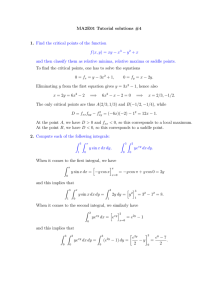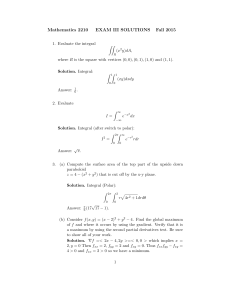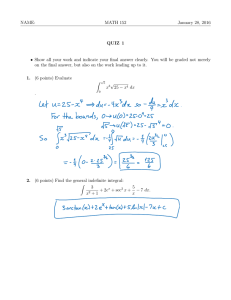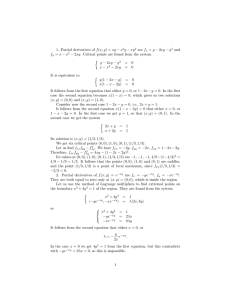Math 263 Midterm II
advertisement
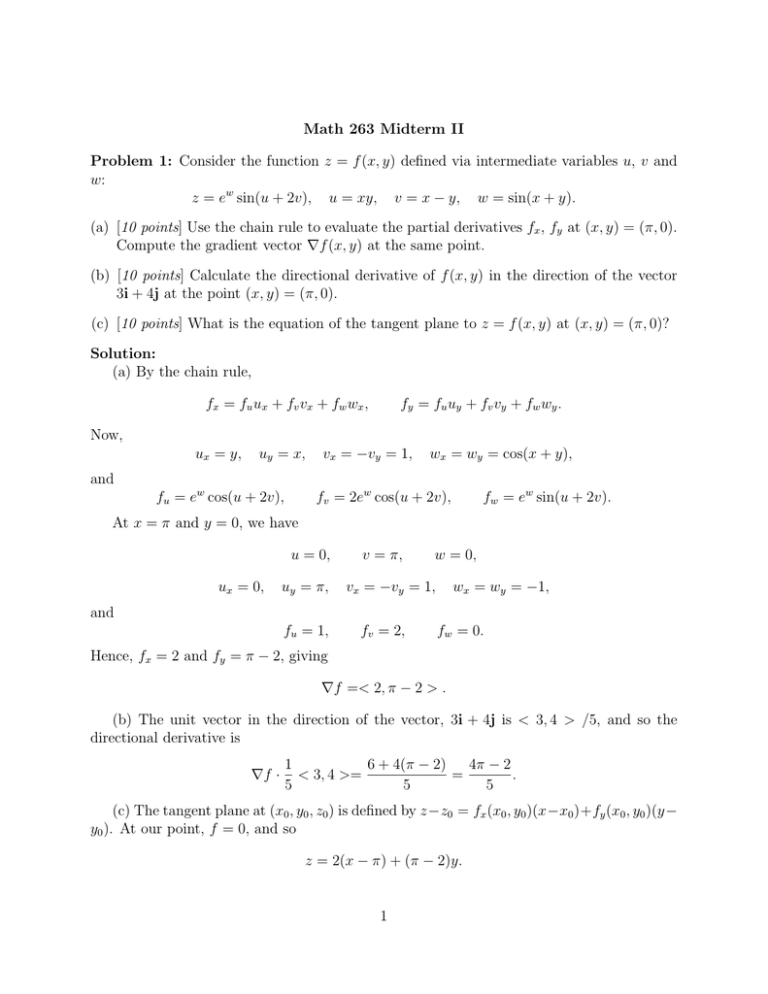
Math 263 Midterm II Problem 1: Consider the function z = f (x, y) defined via intermediate variables u, v and w: z = ew sin(u + 2v), u = xy, v = x − y, w = sin(x + y). (a) [10 points] Use the chain rule to evaluate the partial derivatives fx , fy at (x, y) = (π, 0). Compute the gradient vector ∇f (x, y) at the same point. (b) [10 points] Calculate the directional derivative of f (x, y) in the direction of the vector 3i + 4j at the point (x, y) = (π, 0). (c) [10 points] What is the equation of the tangent plane to z = f (x, y) at (x, y) = (π, 0)? Solution: (a) By the chain rule, fx = fu ux + fv vx + fw wx , fy = fu uy + fv vy + fw wy . Now, ux = y, uy = x, vx = −vy = 1, wx = wy = cos(x + y), and fu = ew cos(u + 2v), fv = 2ew cos(u + 2v), fw = ew sin(u + 2v). At x = π and y = 0, we have u = 0, ux = 0, uy = π, v = π, w = 0, vx = −vy = 1, wx = wy = −1, and fu = 1, fv = 2, fw = 0. Hence, fx = 2 and fy = π − 2, giving ∇f =< 2, π − 2 > . (b) The unit vector in the direction of the vector, 3i + 4j is < 3, 4 > /5, and so the directional derivative is ∇f · 6 + 4(π − 2) 4π − 2 1 < 3, 4 >= = . 5 5 5 (c) The tangent plane at (x0 , y0 , z0 ) is defined by z−z0 = fx (x0 , y0 )(x−x0 )+fy (x0 , y0 )(y− y0 ). At our point, f = 0, and so z = 2(x − π) + (π − 2)y. 1 Problem 2: (a) [10 points] Find the critical points of the function f (x, y) = ex (x − y 2 ). (b) [10 points] Use the second-derivative test to determine whether f attains a local maximum, minimum or saddle point at the critical points. Evaluate f (x, y) at the critical points. (c) [15 points] Determine the absolute maximum of f (x, y) over the closed domain −2 ≤ x ≤ 0, −1 ≤ y ≤ 1. Solution: (a) First partial derivatives: fx = ex (x + 1 − y 2 ), fy = −2ex y. The only critical point is therefore given by (x, y) = (−1, 0). (b) The second partial derivatives are: fxx = ex (x + 2 − y 2 ), fyy = −2ex , fxy = −2ex y. At the critical points, fxx = e−1 , fyy = −2e−1 , fxy = 0. And the discriminant, 2 D = fxx fyy − fxy = −2e−2 < 0. Thus the critical point is a saddle point: f (−1, 0) = −e−1 . (c) Since the critical point is a saddle, the absolute maximum must occur on the boundary of the domain. Along the top and bottom boundaries, y = ±1 and the function value is g(x) = ex (x − 1). g 0 (x) = xex ≤ 0 over −2 ≤ x ≤ 0 and g attains its maximum at x = −2: f (−2, ±1) = −3e−2 . At the left boundary, x = −2 and the function reduces to h(y) = −e−2 (y 2 + 2), which has its maximum at y = 0, h(0) = −2e−2 . At the right boundary, x = 0 and the function reduces to p(y) = −y 2 whose maximum is p(0) = 0. Thus, the absolute maximum of f (x, y) is 0, and it occurs at (0, 0). Note: Full points if one writes that f (x, y) = ex (x − y 2 ) is non-positive over the closed domain, and thus its absolute maximum occurs at the origin, and is 0. 2 Problem 3: (a) [10 points] Consider the three-dimensional region bounded by the surface x 2 + y 2 + z 2 = a2 , and the planes: y = 0, z = 0 and x = y. Set up an iterated double integral in Cartesian coordinates for calculating the volume of the region. Do not evaluate this integral! (b) [15 points] Calculate the above volume using a double integral in polar coordinates. (c) [10 points] Evaluate the integral of g(y) = (sin y)/y over the triangular domain on the xy-plane bounded by x = 0, y = x and y = π/4. Hint: the domain can be seen either as type I or type II, but the iterated integral is much easier in one way than the other. Solution: p (a) Since the curved surface can be rewritten in the form z = a2 − x2 − y 2 , the volume of the region is given by Z Z p a2 − x2 − y 2 dxdy, D where D is the region in the first quadrant of the (x, y)−plane below the line x = y, to the left of the curve, x2 + y 2 = a2 . By integrating first in x, we may write the iterated integral, # Z a "Z √a2 −y2 p a2 − x2 − y 2 dx dy, 0 y (b) In polar coordinates, the region of integration is simply 0 ≤ θ ≤ π/4 and 0 ≤ r ≤ a. Hence, we must evaluate Z π/4 Z a √ dθ a2 − r2 rdr 0 0 a2 √ a2 π πa3 π −(a2 − u)3/2 0 = . a2 − udu = 8 0 12 12 (c) The region of integration is the wedge above y = x and below y = π/4. Hence, Z π/4 Z y sin y dx dy y 0 0 # Z π/4 "Z π/4 sin y = dy dx y 0 x Z = The first integral of the original double integral evaluates to give √ Z π/4 2 y=π/4 sin ydy = [− cos y]y=0 = 1 − . 2 0 3
